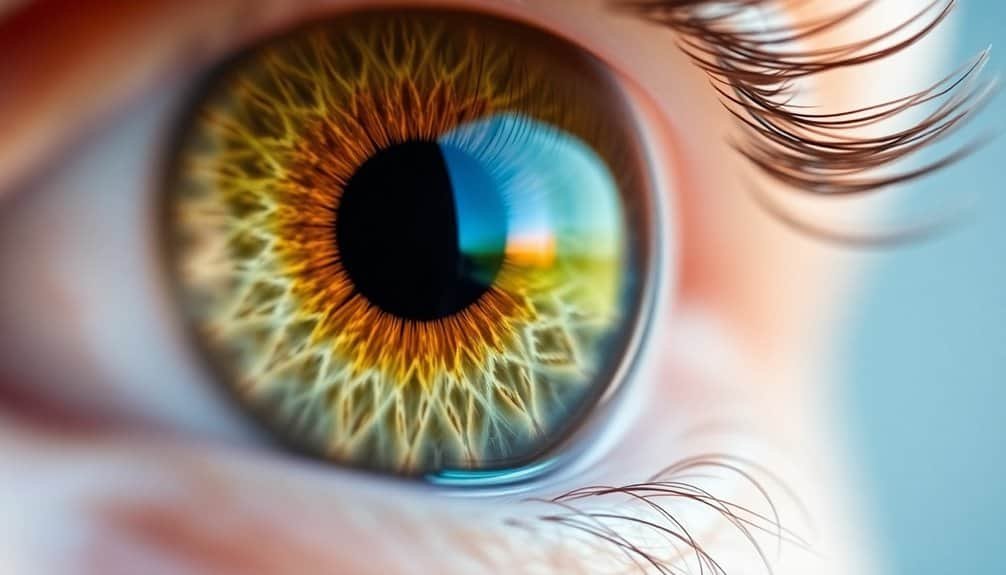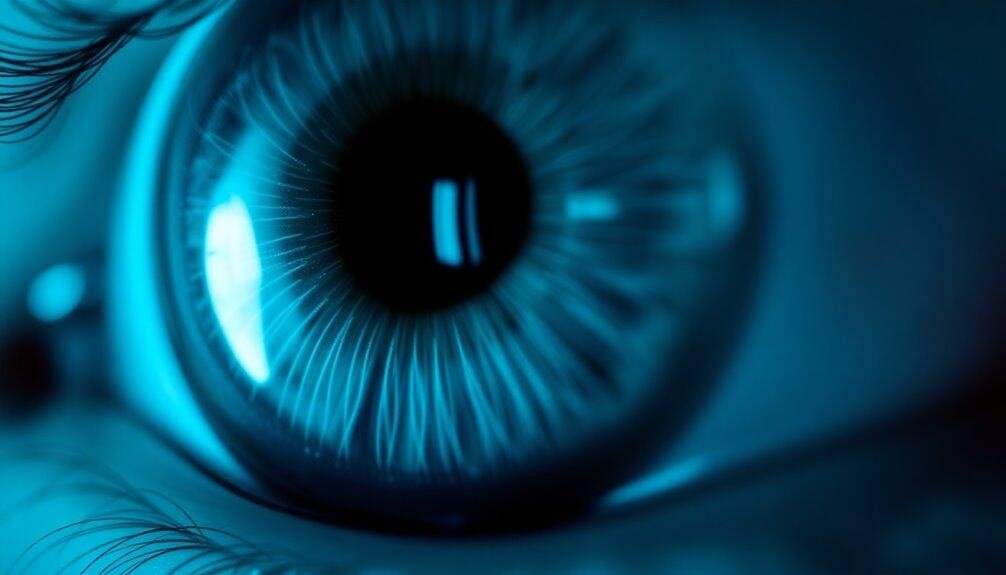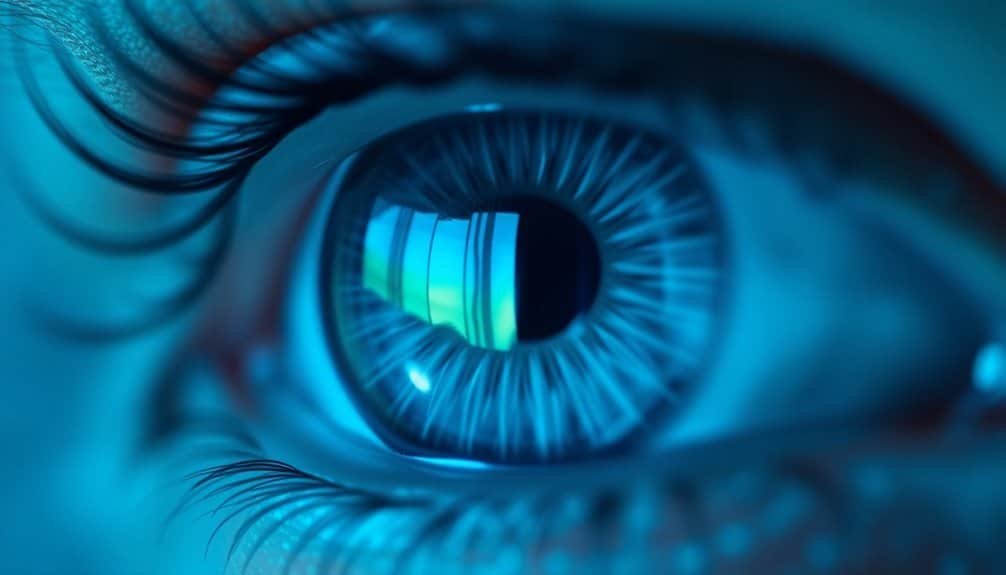RF Radiation and Eye Health (Vision Effects)
RF radiation can impact eye health through thermal effects, with high exposure potentially increasing retinal temperatures and risking cataract formation. Although acute ocular damage in humans is not widely reported, studies suggest potential long-term risks, particularly in children.
Corneal changes and inflammation may occur at higher frequencies, underscoring the importance of following safety guidelines from organizations like Health Canada and the FCC to minimize exposure risks. Further investigation into these implications is needed.
Disclaimer: As an affiliate, I may collect a share of sales from the links on this page.
Effects of RF Radiation on Ocular Tissues

As you explore the effects of RF radiation on ocular tissues, it’s essential to understand the specific impacts on various eye structures.
RF energy can induce cataracts in animals with exposure above certain thresholds, altering lens proteins. Despite this, human studies haven’t shown acute ocular damage from prolonged exposure. Notably, animal studies indicate RF heating can induce cataracts.
The retina may experience harm from high RF levels, as its sensitivity to thermal changes raises concerns. Additionally, RF radiation affects the cornea, particularly in dry conditions.
Even though temperature rises are minimal, they can still impact ocular health. More research is necessary to clarify these effects on human vision.
Short-Term Thermal Effects of RF Exposure
RF radiation exposure can lead to short-term thermal effects, particularly affecting ocular health. High power densities can cause significant tissue heating, making the eyes especially vulnerable.
RF energy absorption leads to localized heating, raising the vitreous body temperature. Temperatures above 41°C may induce cataracts, a primary concern with thermal injury. Cataracts have been observed in experimental animals with localized high RF field exposure, indicating potentially serious consequences of excessive RF energy on eye health.
With limited blood circulation, the eye’s cooling mechanisms can’t dissipate heat efficiently. Prolonged exposure intensifies the risk of thermal damage, and the specific absorption rate (SAR) plays a critical role in determining effect intensity.
Ultimately, staying within regulatory exposure limits is essential to minimize potential ocular harm.
Long-Term Health Implications for Eye Health

While many studies examine the immediate effects of RF radiation on eye health, the long-term implications remain largely unexplored. Current research primarily relies on animal studies, which suggest potential risks like cataract formation in rabbits exposed to high RF levels. However, outcomes vary among species, with monkeys showing no similar effects. Children are at higher risk due to deeper brain exposure making it difficult to make definitive conclusions regarding eye health. Though RF radiation is non-ionizing and generally poses less risk than ionizing radiation, the long-term thermal effects on eye health remain ambiguous. More research is essential to better understand potential health consequences of prolonged RF exposure.
Visual Acuity and Corneal Changes
The ongoing assessment of RF radiation’s impact on eye health extends to visual acuity and corneal changes, focusing on how exposure correlates with functional outcomes.
Studies mainly highlight limited direct effects on visual acuity, often attributing changes to thermal effects over time. Although some research hints at possible alterations in refraction, findings remain inconsistent.
Corneal inflammation, particularly at higher frequencies, has been observed in animal models, revealing how absorbed RF energy can cause tissue damage.
Public Health Guidelines and Safety Standards

Public health guidelines regarding RF radiation exposure are essential for safeguarding health in both public and occupational settings. Organizations like Health Canada and the FCC establish safety standards that limit exposure to prevent potential health risks.
Safety Code 6 and FCC guidelines outline specific exposure limits, guaranteeing compliance. Key metrics like internal electric field strength and the rate of RF energy absorption (SAR) help define these limits.
Additionally, international standards, such as those by ICNIRP, guide regional regulations. Continuous monitoring techniques assess field strengths, and regular compliance checks ensure RF-emitting devices meet established safety criteria, promoting public awareness and safety. Understanding electromagnetic fields is crucial for evaluating the potential impacts of RF radiation on health.
Frequently Asked Questions
Can Wearing Glasses Reduce RF Radiation Exposure to the Eyes?
Wearing glasses doesn’t notably reduce RF radiation exposure to your eyes. Standard eyewear lacks effective shielding, and specialized options aren’t widely available or proven. Keeping distance from the radiation source is your best protection strategy.
Are Children More Vulnerable to RF Radiation Than Adults?
Imagine your child playing with a tablet, unaware of hidden risks. Yes, children are more vulnerable to RF radiation than adults due to their developing bodies and thinner skulls, which expose them to increased absorption.
What Role Does Smartphone Use Play in Eye Health?
Smartphone use greatly affects your eye health. Prolonged screen time can lead to increased eye pain, dryness, and discomfort. Remember to take breaks, blink frequently, and maintain a proper distance to protect your vision.
How Can Individuals Minimize RF Exposure From Devices?
You’ve got a smartphone glued to your hand, right? To minimize RF exposure, use speaker mode, keep devices away from your body, and opt for wired connections whenever possible. It’ll make a difference, trust me!
What Symptoms Indicate Potential RF Radiation Eye Damage?
If you notice blurry vision, light sensitivity, or flashes of light without stimuli, it could signal potential eye damage. Pay attention to redness, discomfort, or persistent irritation as well, and consider seeking professional evaluation.
Conclusion
RF radiation’s impact on eye health requires careful consideration. Short-term thermal effects may affect visual acuity, and long-term exposure could lead to corneal changes. Following public health guidelines and safety standards is crucial to mitigate risks. Raising awareness about RF exposure can help protect our eyes and maintain long-term vision health.






